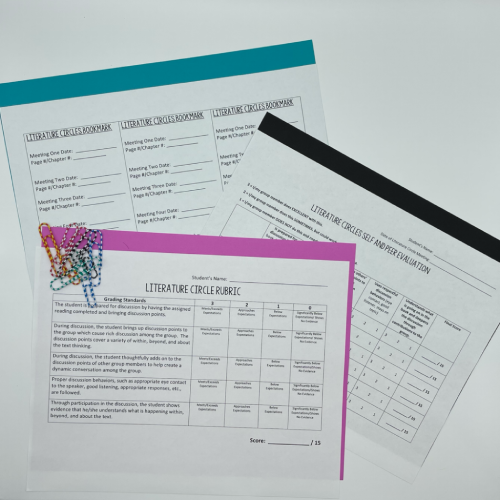I made a commitment to myself and my students before the school year even began. The commitment was this: I will read out loud to my students three days or more per week. After hearing that I teach 8th grade Language Arts, I know some people out there would say to me: “Why?” or “That’s just for younger students” or “That’s a waste of instructional time.” Trust me, I had my own reservations when I made this commitment. I asked the same questions, but I also had read so many articles by people I respected that claimed it was the heart of everything to do with the literacy framework, so I decided to give it a try.
Here are a few quick “down and dirty” tips that I have discovered after over half of a school year with Interactive Read Aloud as part of my daily classroom routine.
1. Make Interactive Read Aloud part of your classroom routine. If you fill out a weekly calendar or follow a daily routine, schedule in Interactive Read Aloud. One guarantee I have is that your students WILL hold you accountable for incorporating this time in once it becomes part of your routine. I have a 90 minutes class period. My daily routine with transitions in my classroom looks like this:
Do Now (Interactive Vocabulary, Sentence Stalking, Close Read, Poetry Analysis): 5 minutes
Interactive Read Aloud: 10 minutes
Reading Workshop: 30 minutes
Writing Workshop: 30 minutes
Share: 5 minutes
2. Pick texts that are going to excite middle school students and get them talking. Also use a variety of genres throughout the school year. Just because you’re reading aloud to middle school students does not in any way mean you have to read them “baby books.” Actually, please DON’T do this. Here are a few books I have read aloud to my students this year and LOVED:
This would be a great book to pair with Out of the Dust to have students compare how Hesse’s writing style and topic choice transfers from one text to another.
This book would be a great mentor text when teaching narrative nonfiction writing because the author uses figurative language while telling the story of Dave’s life.
Much of the language in this text relates to dancing, even though this book is not about dancing, it is about Japanese Internment Camps. A great mentor text for teaching metaphor and also for developing background knowledge about what happened to Japanese-Americans during World War II. This could be a great read aloud to kick off an inquiry circle.
This could be a great entry for students’ Writer’s Notebooks. After watching the video clip, reading the author’s note, and reading the book, students could think back to a story told to them during their childhood by their parents or grandparents and write a story from the first person point of view mimicking this same technique.
This chapter book worked phenomenal as a read aloud because of the incredible voice Sharon Draper creates through the narrator and main character, Melody, a 5th grade who has cerebral palsy and can’t talk but is extremely intelligent. My students had SO much to talk about while reading this book, and it also caused some great conversation of themes and symbols.
This makes for a phenomenal read aloud that could be used in Reading Workshop and Writing Workshop as a mentor text for the use of figurative/descriptive language to explain setting.
Excellent book to use as a read aloud to help develop students’ background knowledge about the Civil War.
This is a great read aloud text to build background knowledge during the Civil Rights unit in Civics. It is definitely worth checking out other titles by this author as her narrative nonfiction work would be a great compliment to our narrative nonfiction unit.
This is a great read a loud for inferring. It also has incredible illustrations that would make for great discussions.
I would recommend this as a read aloud for 7th or 8th grade or older. This read aloud has been a great tie in for interactive vocabulary work and sentence stalking. I have noticed many of my students trying out varying sentence structures in their own writing after using Stein’s writing as a mentor text for this purpose. Themes, voice of the narrator, use of metaphor, and more are just a few of the reasons this has been a phenomenal read aloud.
This is a great read aloud to build background knowledge about what World War II under Nazi rule was like for people living in Paris, France.
This book would be awesome for a point of view minilesson in Reading Workshop. Some students may also want to experiment with writing the same story from the perspective of different characters within the story as Browne did.
A story filled with beautiful language and illustrations with such a strong message, this book would be a great read aloud at the beginning of the year to serve as a mentor text in Reading and Writing Workshop alike.
3. Choose a few places to stop throughout the read aloud, but don’t stop too much (this kills the flow and enjoyment of the book). Give students opportunities to talk about text when you stop through a turn and talk, writing down their ideas and then sharing out, sharing with the whole class. This is also a great time to model your own thinking about reading so that students have a great model for what this looks like.
Interactive Read Aloud can be incorporated into all the instructional contexts of a literacy classroom. I blogged about that here:
Have fun reading aloud to your students and make sure to sit back every once and awhile and notice how, regardless of their age, how engaged they are during this time.
If you’d like to purchase any of the titles above, visit the links below to buy off of Amazon.
Come On, Rain!
Dave the Potter: Artist, Poet, Slave
Music for Alice
My Freedom Trip: A Child’s Escape from North Korea
Out of My Mind
 Owl Moon
Owl Moon
Pink and Say
Sit-In: How Four Friends Stood Up by Sitting Down (Jane Addams Honor Book (Awards))
The Butterfly
Voices in the Park
When Marian Sang: The True Recital of Marian Anderson


















